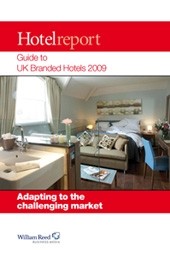Hotel Report Guide to UK Branded Hotels 2009

With the recession biting hard, how is the UK branded hotel market changing?
All the answers and more can be found in the Hotel Report Guide to UK Branded Hotels 2009. Containing completely new, originally researched content, it will give you an essential overview of the UK market.
Written by leading market experts, the 2009 Guide provides comprehensive data and in-depth analysis, with comment and opinion from leading commentators and senior players. Entitled Adapting to the challenging market, the Hotel Report Guide really gives an essential insight into what is happening today.
You will also find full operator listings in this new Guide.
See below for a preview of this indispensable Report.
To view a sample of the guide or order, click here
UK Price: £485.00 VAT (£72.75)
EU Price: £510.00 VAT (£76.50)
Rest of World Price: £535.00
PDF Price: £485.00 VAT (£72.75)
Buy-to-let hotels
by Phil Cain
“Earn money while others sleep,” was the dreamy catchline of GuestInvest, an idea made real in an animation where zeds magically morph into pound signs. In reality, however, the buy-to-let hotel company proved more successful at turning pounds signs into thin air.
It all began in late 2004 when GuestInvest’s founder Johnny Sandelson invested £3.4m to build one of the UK’s first buy-to-let hotels, Guesthouse West, a 20-room hotel in Notting Hill, London. The novel idea drew wide- spread coverage from the mainstream business press, notoriety which helped Sandelson to sell all the rooms in under four months.
By 2006 GuestInvest’s kudos was sufficient to persuade HBoS to hand over £200m and take a 19.9% equity stake in the business, provide a line of credit and bring finance veteran Sir Mark Weinberg to the board as a non-executive director.
It was by no means outlandish to think the idea of buy-to-let hotels might take off in the UK. In the US it is a common element of hotel developments, although such schemes tend to go by the name of “condominium hotels”.
Some US schemes, like the Mondrian in Miami, tapped into the UK public’s voracious appetite for property by advertising. In France buy-to-let schemes offer a tax-efficient pension investment, with investors allowed to move into their property after 20 years.
By summer 2007 GuestInvest had bought two more London properties and, having failed to make the idea work in the provinces, was looking overseas. “I plan to introduce the concept all over the world – Amsterdam, Milan, Paris and even as far as Istanbul,” Sandelson said at the time.
Hundreds invested between £250,000 and £1m for a 999-year lease on a GuestInvest room. GuestInvest even offered to lend them up to 70% of the purchase price. The outlay entitled investors to half the room’s rental income and a “free” room for 52 nights a year. A 6% return was guaranteed in the first year, but after that there was no safety net and a decision to refurbish could mean actually paying money out. In the end, however, it was simply falling occupancy and the squeeze on credit that put paid to the idea and Deloitte was called in as administrator on 2 October 2008. A buyer for the properties has still to be found.
“The future for the buy-to-let hotel market is unclear at best,” says Jeremy Hill, director and head of hotels at Christie & Co. “Many observers are still unsure if the model is robust especially outside key cities. There is also still little evidence of there being a resale market in regards to the buy-to-let sector, which has generally put investors off. The continuing decline in hotel performance and the fact that there is currently less investment in the whole hotel sector in general means that demand for buy-to-let schemes may decline further.”
Another buy-to-let hotel pioneer, Galliard, seems to have fared better having begun selling its rooms in 2004, a few months before Sandelson bought his first hotel. In early summer that year it began offering 395 rooms ‘off plan’ in the County Hall Park Plaza near Waterloo for between £200,000 and £700,000. In a twist on the GuestInvest model, Galliard offered guests 30 days in the hotel in exchange for one percentage point of their annual return, which was guaranteed to be 6% for the first eight years. “We sold all the suites early on,” says Madeleine Flower, Galliard’s marketing manager. Since opening its doors in February last year the hotel has operated at over 80% occupancy, she adds.
Galliard and property developer Frogmore Property Company also co-own a buy-to-let hotel, again to be managed by Park Plaza after it opens in 2010. Most of the 940 suites in what will be called the Westminster Bridge Park Plaza have now been sold, Flower says.
But will Galliard be venturing into the buy-to-let market again in the near future? “Not at the moment,” admits Flower. “But we might if the opportunity offered itself in the right location and the economic climate were a bit more ‘user friendly’.”
But there are those who actually see the buy-to-let model as a timely solution to the financial deadlock.
“There is a growing demand at the moment, because people need income. If we can deliver 7-8% pre-tax yields, that has got to be attractive,” says Stuart Law, chief executive of property company Assetz, which plans to set up a buy-to-let financed budget boutique chain called Hotelz.
The brand hopes to take the buy-to-let model outside London and serving 40 of the top 60 UK cities. Like GuestInvest, but unlike Galliard, it plans to act as the operating company itself. “As an assets group as a whole we will effectively own the operator,” Law explains.
“We wish to have control of and take responsibility for the operation and hence the rental income of the hotel rooms,” Law says. He adds that the operations team for the nascent chain have over 20 years’ experience each.
The Assetz model differs from both GuestInvest and Galliard’s by physically separating the investor from their room. “Personal usage is not an option by default in any of our hotels. This is a proper business proposition. You do not get lots of usage in these hotels, even the one we might do in, say, Barcelona,” Law says. Assetz is also only proposing to offer room owners 40% of the income from the rooms, rather than the 50% offered by GuestInvest.
“We will still achieve yields of around 8% on modest revpar,” Law says. He adds he is hopeful of selling whole floors or even whole hotels to pension syndicates.
What stage is the roll out of the new brand at now? “We are looking to buy one or two hotels in good city centre locations which fit our model: smaller rooms, 10 to 15 square metres with an interesting look and feel, contemporary design, in one of the bigger cities and very central location, no parking required.” In a year’s time he hopes to have opened the first hotel and to have one or two more in the pipeline “so we have the beginnings of a chain”.
The year after he hopes to have another two or three.
The buy-to-let system offers considerable advantages to the developer, according to Law, because it amounts to flexible finance where the cost flexes with income. This could become very valuable if interest rates climb as they might following recession-busting government spending.
“Because of our model of selling the rooms, building the first five to seven hotels only requires a peak equity of under £5m, which is very aggressive and includes overlapping development of hotels.”
Buy-to-let might not be the whole solution, however: “In the real world we need a blended mix of funding solutions. We could launch a plc, that’s already been discussed, and some of these hotels will be funded by private investors,” Law explains.
Despite its rocky start in the UK, the buy-to-let model does not seem likely to completely disappear. But, like buy-to-let more generally, its potential to enrich has been put into perspective.



















